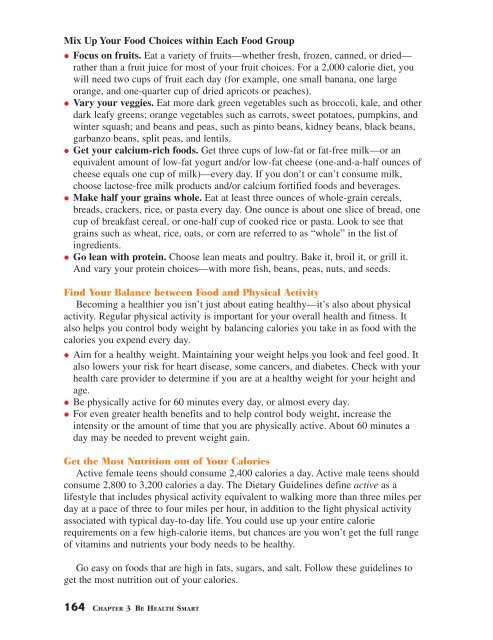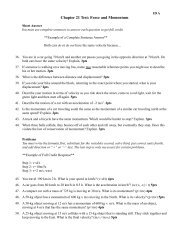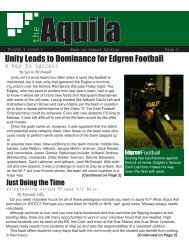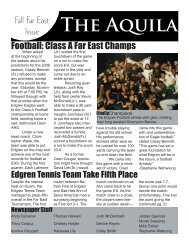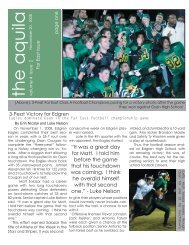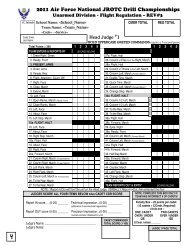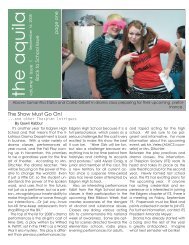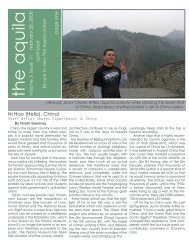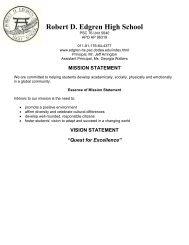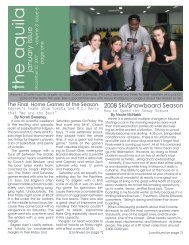AFJROTC Student Workbook CH03_Lesson_2 - Edgren High ...
AFJROTC Student Workbook CH03_Lesson_2 - Edgren High ...
AFJROTC Student Workbook CH03_Lesson_2 - Edgren High ...
You also want an ePaper? Increase the reach of your titles
YUMPU automatically turns print PDFs into web optimized ePapers that Google loves.
<strong>CH03</strong>_LE1 6/28/05 4:19 PM Page 164<br />
Mix Up Your Food Choices within Each Food Group<br />
• Focus on fruits. Eat a variety of fruits—whether fresh, frozen, canned, or dried—<br />
rather than a fruit juice for most of your fruit choices. For a 2,000 calorie diet, you<br />
will need two cups of fruit each day (for example, one small banana, one large<br />
orange, and one-quarter cup of dried apricots or peaches).<br />
• Vary your veggies. Eat more dark green vegetables such as broccoli, kale, and other<br />
dark leafy greens; orange vegetables such as carrots, sweet potatoes, pumpkins, and<br />
winter squash; and beans and peas, such as pinto beans, kidney beans, black beans,<br />
garbanzo beans, split peas, and lentils.<br />
• Get your calcium-rich foods. Get three cups of low-fat or fat-free milk—or an<br />
equivalent amount of low-fat yogurt and/or low-fat cheese (one-and-a-half ounces of<br />
cheese equals one cup of milk)—every day. If you don’t or can’t consume milk,<br />
choose lactose-free milk products and/or calcium fortified foods and beverages.<br />
• Make half your grains whole. Eat at least three ounces of whole-grain cereals,<br />
breads, crackers, rice, or pasta every day. One ounce is about one slice of bread, one<br />
cup of breakfast cereal, or one-half cup of cooked rice or pasta. Look to see that<br />
grains such as wheat, rice, oats, or corn are referred to as “whole” in the list of<br />
ingredients.<br />
• Go lean with protein. Choose lean meats and poultry. Bake it, broil it, or grill it.<br />
And vary your protein choices—with more fish, beans, peas, nuts, and seeds.<br />
Find Your Balance between Food and Physical Activity<br />
Becoming a healthier you isn’t just about eating healthy—it’s also about physical<br />
activity. Regular physical activity is important for your overall health and fitness. It<br />
also helps you control body weight by balancing calories you take in as food with the<br />
calories you expend every day.<br />
• Aim for a healthy weight. Maintaining your weight helps you look and feel good. It<br />
also lowers your risk for heart disease, some cancers, and diabetes. Check with your<br />
health care provider to determine if you are at a healthy weight for your height and<br />
age.<br />
Be physically active for 60 minutes every day, or almost every day.<br />
•<br />
For even greater health benefits and to help control body weight, increase the<br />
intensity or the amount of time that you are physically active. About 60 minutes a<br />
day may be needed to prevent weight gain.<br />
Get the Most Nutrition out of Your Calories<br />
Active female teens should consume 2,400 calories a day. Active male teens should<br />
consume 2,800 to 3,200 calories a day. The Dietary Guidelines define active as a<br />
lifestyle that includes physical activity equivalent to walking more than three miles per<br />
day at a pace of three to four miles per hour, in addition to the light physical activity<br />
associated with typical day-to-day life. You could use up your entire calorie<br />
requirements on a few high-calorie items, but chances are you won’t get the full range<br />
of vitamins and nutrients your body needs to be healthy.<br />
Go easy on foods that are high in fats, sugars, and salt. Follow these guidelines to<br />
get the most nutrition out of your calories.<br />
164 CHAPTER 3 BE HEALTH SMART


